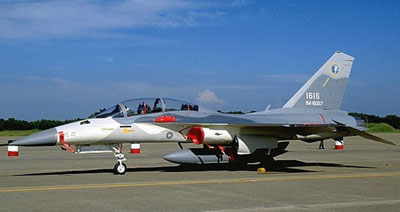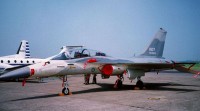Global Aircraft -- Ching-kuo
|
Aviation Center
US Attack
US Bombers
US Cargo
US Fighters
US Helicopters
US Patrol/Pursuit
US Reconnaissance
US Tankers
US Trainers
US UAV's
US X Planes
Orbiter Vehicles
WWI Aircraft
WWII Aircraft
Airbus
Antonov
Boeing
Dassault
Ilyushin
Kamov
MiG
Mil
Saab
Sukhoi
Tupolev
Yakovlev
Joint/Rest of World
Entertainment Center
Members Center
New Technologies
Contact Us
Extra Navigation
GAC Engine
Ching-kuo Specifications
Ching-kuo Features
The AIDC officially began the IDF development project in 1982 following the ROCAF's failure to purchase new fighters from the United States as a result of the PRC's diplomatic pressure. The project was named An Hsiang and divided into four sections in 1983:
* Ying-Yang: "Soaring Eagle". Development of the airframe. Cooperation with General Dynamics. * Yun-Han: "Galaxy". Development of the aircraft powerplant and propulsion. Cooperation with Garrett (Now Honeywell). * Tien-Lei: "Sky Thunder". Development of the avionics systems. Cooperation with Smiths Industries, with some components purchased directly from Lear Astronics (later BAE), Litton (later Northrop Grumman), and Martin-Baker. * Tien-Chien: "Sky Sword". Development of air-to-air missiles. The IDF was designed to counter the People's Liberation Army Air Force's J-8, J-7, and newer fighters such as the J-12, with the intention for the aircraft to have performance on par with the F-16 and Mirage 2000, since both F-16 and Mirage 2000 fighters had been offered to PLAAF before 1989.The greatest difficulties were encountered by the propulsion group in attempting to develop or acquire suitable advanced jet engines. There is also speculation that the use of weaker engines was due to political rather than technical reasons, namely that the US did not want to see Taiwan provoke the PRC and thus mandated the IDF to have a "range no greater than the F-5E" and "ground attack capability no greater than the F-16". Regardless of the reason, many people consider the F-CK-1 to be somewhat underpowered, meaning that its performance is not at the same level as other ROCAF fighters (i.e the Block 20 F-16). Exports of advanced engines such as the General Electric F404 or the Pratt & Whitney F100 weren't available to Taiwan. Both the General Electric J85 and General Electric J79 were considered unsuitable in their performance, and most European and American engine companies declined to cooperate with Taiwan. Joint investment with Garrett became the only practical solution. In 1978, following the success of the TFE-731 engine, U.S. engine company Garrett announced joint research of the TFE-1042 afterburner with Swedish company Volvo Flygmotor AB. The TFE-731 Model 1042 was touted as a low bypass ratio "military derivative of the proven commercial TFE 731 engine" and that it would provide "efficient, reliable, cost effective propulsion for the next generation of light strike and advanced trainer aircraft", with a thrust of 4260 lbf (18.9 kN) dry and 6790 lbf (30.2 kN) with afterburner. After the initial negotiation, the investment was going to be divided between Garrett, Volvo, AIDC, and Italian company Piaggio. The development would consist of the non-afterburning TFE-1042-6 for light attack aircraft and advanced trainers, and the TFE-1042-7 for the AMX or the F-5 upgrade. AIDC also suggested upgrading the TFE-1042-7 to 8,000 lbf (36 kN) thrust in a twin-engine installation, in order to compete with the GE F404. However, the JAS 39 Gripen project decided to continue with a single F404, and Piaggio asked to participate at a later date due to financial concerns. Thus only Garrett and AIDC invested in the new International Turbine Engine Corporation (ITEC), with the contract signed in 1982. The engine requirements changed after the IDF's role shifted from a high-speed interceptor to an air superiority fighter at the end of 1982. ITEC completely redesigned the TFE-1042-7 into the TFE-1042-70 - for example, the bypass ratio was changed from 0.84 to 0.4 -, and the investment had increased from USD 1.8 billion to about USD 3.2 billion. However, to avoid pressures from the PRC, the United States government had asked all the US companies cooperating with Taiwan on the IDF project to remain low-key. Therefore, the perception that "the TFE-1042 is merely the civilian engine TFE-731 with an afterburner" was never completely dispelled. In 1985, the preliminary review of the IDF's design revealed some performance requirement shortfalls, and it was determined that an upgrade of engine thrust by 10% was the simplest solution. Due to American export license restrictions, ITEC used FADEC to artificially limit the thrust below a certain altitude (the restriction was not removed until 1990). Although the upgrade essentially used the TFE-1088-11 configuration, to reduce political interference ITEC renamed the original, lower-thrust version as the TFE-1042-X70 and retained the TFE-1042-70 designation for the upgraded version. In 1988, ITEC decided to invest in the 12,000 lbf (53 kN) thrust TFE-1088-12, which was re-designated as the TFE-1042-70A for political reason as well. Preliminary studies had shown that the IDF could supercruise with the new engine. At the same time, General Electric decided to enter the market with the J101/SF, a smaller version of the F404. However, after the IDF order was cut in half due to budget concerns, the TFE-1088-12 engine upgrade plan ended as well.Since then, there are many rumors of AIDC completing engine upgrade research in private, however, the ROCAF and AIDC never officially announced any IDF fleet engine upgrade. The cooperation between AIDC and General Dynamics (GD) was divided into four phases: 1. GD would analyze the ROCAF aircraft performance and force requirements. 2. Taiwan would assess GD's reports and choose between AIDC's original design and GD's new design. 3. AIDC would send personnel to GD for preliminary design. 4. GD would send personnel to Taiwan to complete the project. It should also be noted that GD's assistance was restricted by the US State Department's arms export control, which limited GD's work to initial design consulting but not further development, production, or marketing. Many different airframe design concepts were explored (i.e. the 2D Thrust-Vectoring nozzle of XX-201, the double delta wings/twin tailed 401). After the General Electric J79 was officially abandoned as the potential engine solution in 1983, three configurations emerged from AIDC. Configuration A was similar to the F-5E. Configuration B was similar to the Eurofighter Typhoon and Saab Gripen. Configuration C was similar to the F-15. At the same time, GD worked on the G configuration in parallel. Eventually the G-4 was selected, but with many features of the C-2 integrated. During this time, the project was named the "Light Weight Defense Fighter". In 1985, the configuration conceptual design had evolved into the SE-1 preliminary design. By the end of 1985, AIDC decided to skip the prototype stage and go into Full Scale Development (FSD) directly, in order to reduce time and save money. The project was again renamed into the "Indigenous Defense Fighter". Four FSD aircraft were made, with three single-seaters and one double-seater. The IDF is equipped with a GD-53 Golden Dragon multi-mode pulse-Doppler radar, which is essentially the General Electric AN/APG-67 X band developed for the F-20 which claims to share some components and technologies of AN/APG-66 of F-16, and this adaptation resulted in the look-down and shoot-down capability of GD-53 being greatly enhanced in comparison to that of the original AN/APG-67, reaching that of the AN/APG-66. The radar can simultaneously track 10 targets and engage one of the 10 targets tracked with semi-active radar homing air-to-air missiles. The design is inherently unstable in pitch, so the IDF incorporated a modern triple-redundant full authority fly-by-wire control system. The avionics suite was based on modular architecture with dual redundant MIL-STD-1553B digital MUX bus. The Honeywell H423 INS, the TWS-95 RHAWS, and the Bendix-King HUD were selected.Some capabilities may have been delayed or dropped in order to meet the performance requirement, since the engine limitation has resulted in the necessity of strict weight control. The CSIST's Tien Chien project was slightly more independent, since it was considered by some officials to be a development for all the ROCAF's aircraft rather than only the IDF. The Tien Chien 1 (TC-1) is a short range infrared-seeking missile with an external configuration similar to that of the AIM-9 Sidewinder, while the Tien Chien 2 (TC-2) is an active radar homing Beyond Visual Range missile that is claimed to be in the same class as the AIM-120 AMRAAM. The first test firing of the TC-1 was made by an F-5E in April 1986, with the Beech target drone successfully destroyed. Initial production of the TC-1 began in 1989, and it entered service in 1991. Both the AIM-9 and the TC-1 appeared on operational IDFs.The production quantity is unknown. CSIST is believed to have cooperated with Motorola on the TC-2's active seeker, likely based on the Motorola design proposed for the AIM-120 but not selected by the United States. 40 pre-production TC-2 missiles were produced before 1995, and were the only BVR AAMs ROCAF/Taiwan had in inventory during the 1995-1996 Taiwan Strait Missile Crisis. 210 production TC-2s are planned, however the production status and timeline is unknown.
Ching-kuo Background
The preliminary search for a replacement for the ROC (Taiwan) Air Force's F-5s and F-104s began with the XF-6 indigenous fighter project, later renamed Ying Yang, in the late 1970s. After the US established formal relations with the People's Republic of China and ended the Mutual Defense Treaty with Taiwan, President Chiang Ching-Kuo decided to expand the indigenous defense industry and on August 28, 1980, ordered AIDC to design an indigenous high-speed interceptor. Originally, the ROCAF listed the priority of the XF-6 behind the XA-3 Lei Ming attack aircraft, due to the believed high risks of the XF-6 project.
The signing of the 1982 US-PRC Joint Communiqué, which would limit arms sales to Taiwan, effectively ended the possibility of the ROCAF obtaining either F-16s or F-20s, therefore ensuring the continuation of the indigenous fighter project. Although US President Ronald Reagan reluctantly accepted his advisers' suggestion of building relations with the PRC to counter the USSR, Reagan decided to balance the 1982 US-PRC Communiqué with the "Six Assurances" to Taiwan. This opened the door for covert US technology transfer and assistance to Taiwan's defense industry, including the IDF project. | ||||||||||||||||||||||||||||||||||||||||||||||


